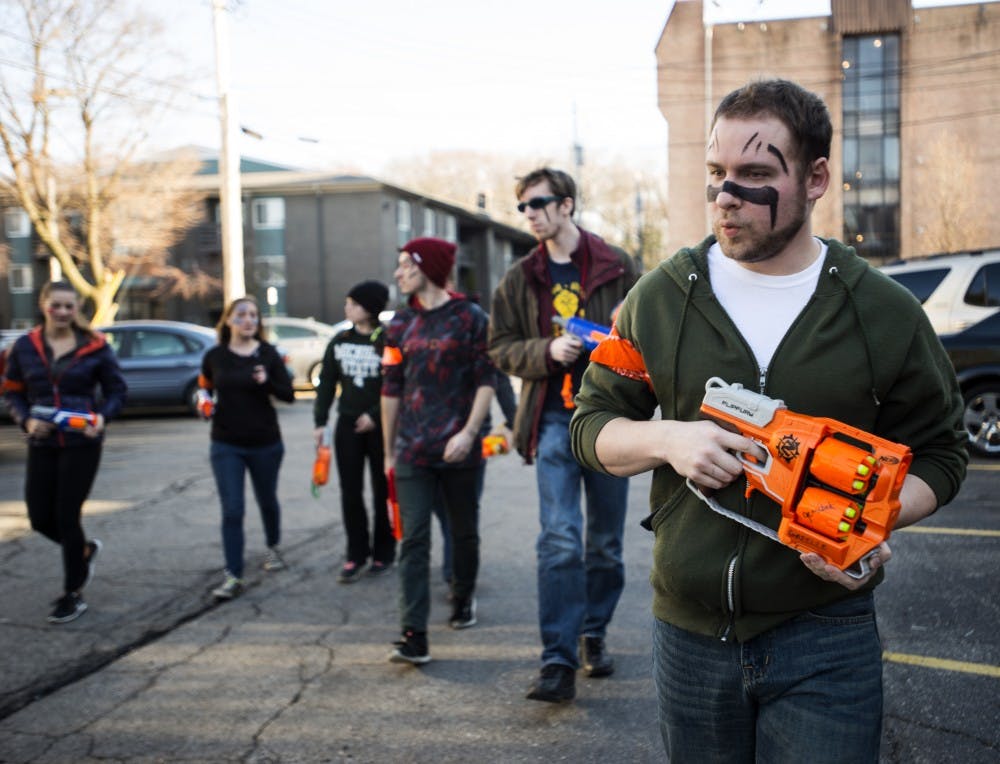Humans have lost Beaumont Tower and zombies have taken over.
As the horde charges forward from the now-infected landmark, the retreat begins. Survivors flee the incoming threat, computer science junior Diego Carrillo and his group stay back to help them escape. They use Nerf guns and hold the zombies off, stunning them while others run.
A bunch of students running around with Nerf guns, bandanas and face paint might leave some wondering why these students are not in class, but for its players, Spartans vs. Zombies is not only a game, but a part of the campus experience.
“Everybody likes to play it, it’s an amazing experience,” Carrillo said. “I really love it.
The 2016 game of Spartans vs. Zombies is in full swing from April 11 until April 16. Independently organized every spring by MSU students, according to the game’s website the event is “a free, week-long game of tag with over 400 annual players.”
As the name suggests, Spartans vs. Zombies splits participants into teams of humans and zombies.
All players have a bright orange bandana, which signifies their allegiance.
Humans wear their bandanas on their arms while zombies wear their bandanas tied around their forehead.
Humans may temporarily stun zombies by hitting them with Nerf darts or a thrown sock, but when a zombie tags a human they are infected and turn into a zombie.
“Everybody starts off as humans except for a select few people, those people are ‘original zombies,’” international relations senior and Spartans vs. Zombies lead admin Aaron Rozin said. “Instead of wearing the bandana on their heads, they wear it on their arms just like humans do. ... On day one they walk around with their blasters ... and that’s how the infection begins, they will tag people (while acting) as a human. It’s mass paranoia on the first day.”
Rozin said he has never played Spartans vs. Zombies himself, but has acted as an admin since 2013.
He said he helps plan and police the game, wearing a purple bandana and making sure the rules are followed.
Rozin said he helps to plan missions, which are daily events during which humans have to complete an objective while the zombies try to stop them.
Missions are where the most action and the most infection takes place, Rozin said.
While buildings are usually safe havens, anyone who enters one during a mission will have to sit out for the remainder of it. A Marshawn Lynch summary of each mission’s objectives and results can be found online.
Lynch is a former NFL running back. Rozin said he couldn’t explain the group’s fascination with Lynch.
Carrillo, a diehard player, said he has enjoyed the game ever since joining in the second semester of his freshman year. He was one of the few survivors of last year’s game.
“It’s been one of my favorite events at the university so far ... it’s pretty amazing, it’s one of those things that I’ve gotten to meet people from every single neighborhood,” Carrillo said.
Spartans vs. Zombies continues until April 16, when one side will emerge victorious.
According to statistics posted on the game’s Facebook page, as of Wednesday at 12:32 a.m. 260 out of 340 total players were still alive while 80 were zombies. This ratio is likely to change drastically in the coming days.
Support student media!
Please consider donating to The State News and help fund the future of journalism.
“Try it out, sign up,” Carrillo said. “Trust me on this, it’s a lot of fun.”
Rozin, soon to graduate, said he is looking for students to help run next year’s game.
He can be contacted through the group’s Facebook page.
Discussion
Share and discuss “Spartans vs. Zombies draws more than 300 participants” on social media.







